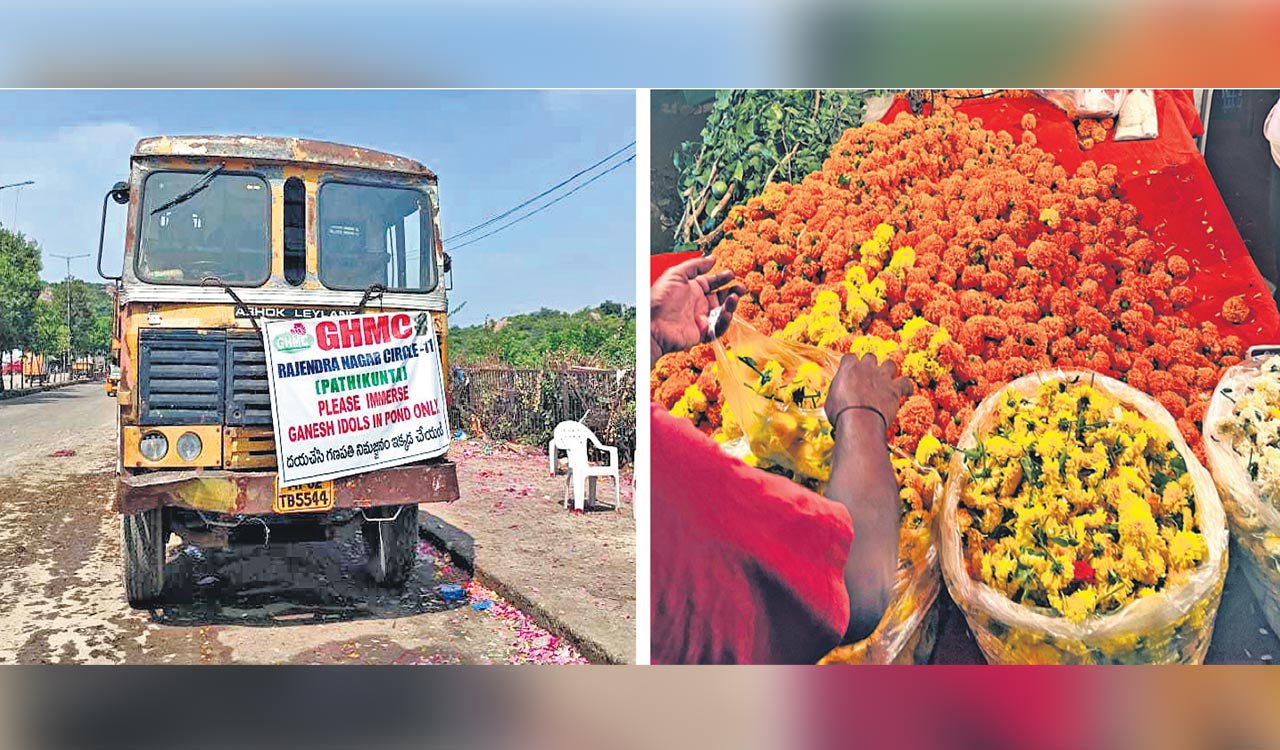Telangana govt’s multi-pronged strategy acted as an umbrella helping petty shops make the most during Ganesh Puja
Published Date – 11:45 PM, Fri – 6 October 23

Prof Sujit Kumar Mishra
The cultural geography of towns like Hyderabad makes them unique. This city is the provider of livelihood to thousands of people from nearby towns and villages, and even those from outside the State – both in formal and informal sectors irrespective of their class, caste, religion and gender. Of the different categories of livelihoods – especially in the informal sector – offered by the city, an important occasion is the Ganesh festival.
Three years of virological uncertainties — two years of pandemic and one year of adjusting to the new situation — have come to an end. Travelling on the Masjid Banda to Kondapur road — a patch of 5 km, two days before Ganesh Chaturthi, I saw several temporary petty shops lined up on the road for the 10-to-12-day event. They were thrice the previous year’s crowd in terms of the number of people involved in the market — both sellers and buyers.
Thanks to the Telangana government for its institutional arrangements, especially the Traffic Police which ensured traffic movement was smooth, sellers could transact hassle-free. Fortunately, the event coincided with the weekend this year. Many other family members too went hand in hand with the vendors. This made it possible to rope in more saleable items thereby increasing the probabilities of income.
Cultural Geography, Livelihoods
I identified 16 different categories of informal livelihood earners in the city and interacted with many of them. These included sellers of Ganesh idols, flowers, leaves, fruits and kirana items, porters who were involved in the transportation of Ganesh idols, panthalu associated with conducting the puja, decorators for pandals, tailors, artisans, milk suppliers for the prasadam, drum beaters during the immersion, women labourers who carry the decorative lights during idol immersion, temporary tiffin vendors, tea sellers and tempo drivers.
“I got more flowers this time but within no time all got sold by afternoon so I had to get more. The main productive period of the market starts from 5 pm,” said Sultana who comes every year during this occasion to sell flowers and garlands in the Masjid Banda area.
I had another interesting conversation with Suresh, a seller of Ganesh idols two days before the puja. He said the prices ranged from Rs 5,000 to Rs. 15,000 depending upon the height of the idols. I tried to negotiate with him for a particular price but instead of entering into the bargaining process, he suggested I visit him the next day. I was surprised but later realised that this was his way of overcoming asymmetric information about market prices and he was using the gestation period of one day to gather information and strengthen his bargaining power. This was possible since the market this time was not affected by external shock.
This enabled him to predict the price for the next two days. Besides, he was a part of all the stages of the price-determining process and was, therefore, in a position to undertake risk to maximise his revenue which was not possible last year. Often, such small vendors become victims of distress sale because of the unpredictability of the market and are unable to even cover the expenditure.
Rethinking Livelihood
The pandemic was a difficult time for artisans involved in the construction of idols. In the Lingampally area, one artisan lamented, “for months together, we were sitting at home due to corona. Others can engage in some work or the other, unlike us artisans.” The people associated with this kind of occupation are basically a minority group, owing to their specialisation in that field. Hence, their participation in the labour market is quite complex and, in many ways, different from the rest. Due to a lack of other skills, they were unable to influence even the normal wage rate in an already saturated labour market. Ratan, an artisan from the Kukatpally area, was extremely happy this year as they could sell many idols.
According to him, the duration of employment of an artisan is directly related to the height, size and number of the idols – the higher the height, size and number of idols, the longer the duration of employment. “I have been working here for the last six months with my son, especially for the making Ganesh idols,” he added. Discussions with the panthalu and drum-beaters revealed the same trend.
Institutional Initiatives
After two years of complete restriction and one year of adjustment process, predicting a big crowd this year was obvious; and this could have brought in disruption in the normal lives of the people. Therefore, the Telangana government took multi-pronged approaches to help these informal livelihood earners in a holistic manner which acted as an umbrella facilitating the linkages between different sectors and stakeholders. First, the credit goes to the Police Department and the Traffic Police. They were quite alert since the transactions for the festival started in the market. In many places, road diversion maps were installed. Also, 108 Ambulance services were found at different places.
Focusing on the environment, the Telangana government created artificial ponds at many places for immersion in Hyderabad. Bins were arranged to deposit puja-related waste. Trucks were arranged to clean the ponds at regular intervals. Free drinking water services were also made available for the public. Special attention was given by the Electricity Department to monitor the issues related to power supply. These arrangements enabled the livelihood earners to maximise their income during all the days of the festival.
Employment Cycle
It has been observed that people engaged in this sector work throughout the year at different scales. First, any disruption has a direct bearing on livelihoods, leading to their marginalisation and alienation. Second, whatever they earn, they consume in different ways and are habituated to this employment cycle, and mostly plan for their future expenditure in advance. In any kind of exigency, they take loans and repay them in subsequent productive seasons due to a lack of savings.
Cumulatively, these factors magnify the precariousness of a large number of people deriving their livelihoods from the informal sector and render them helpless. Hence, the need of the hour is to develop strategies with clear objectives and implement them with proper monitoring, especially in the economic and financial realm.






